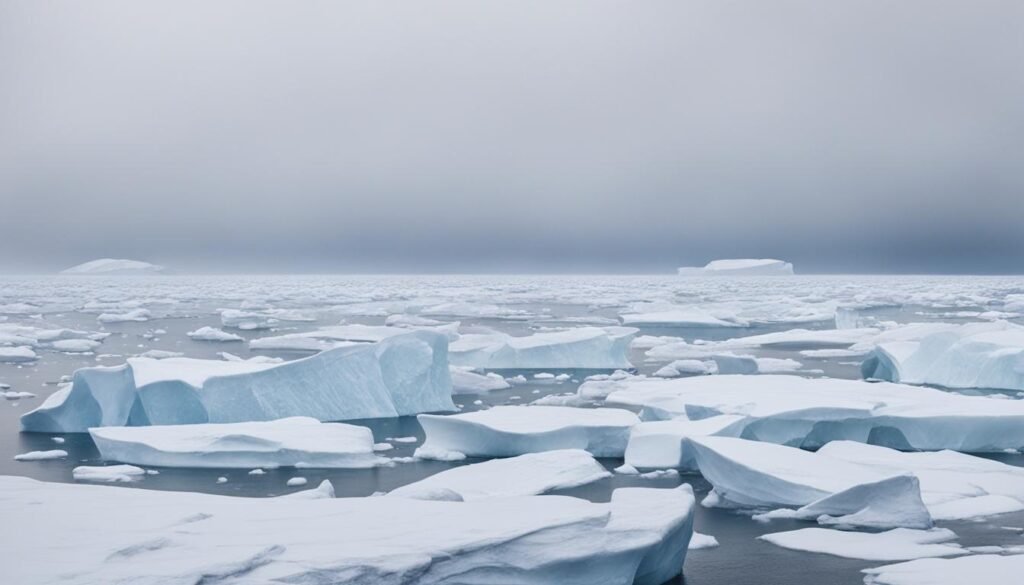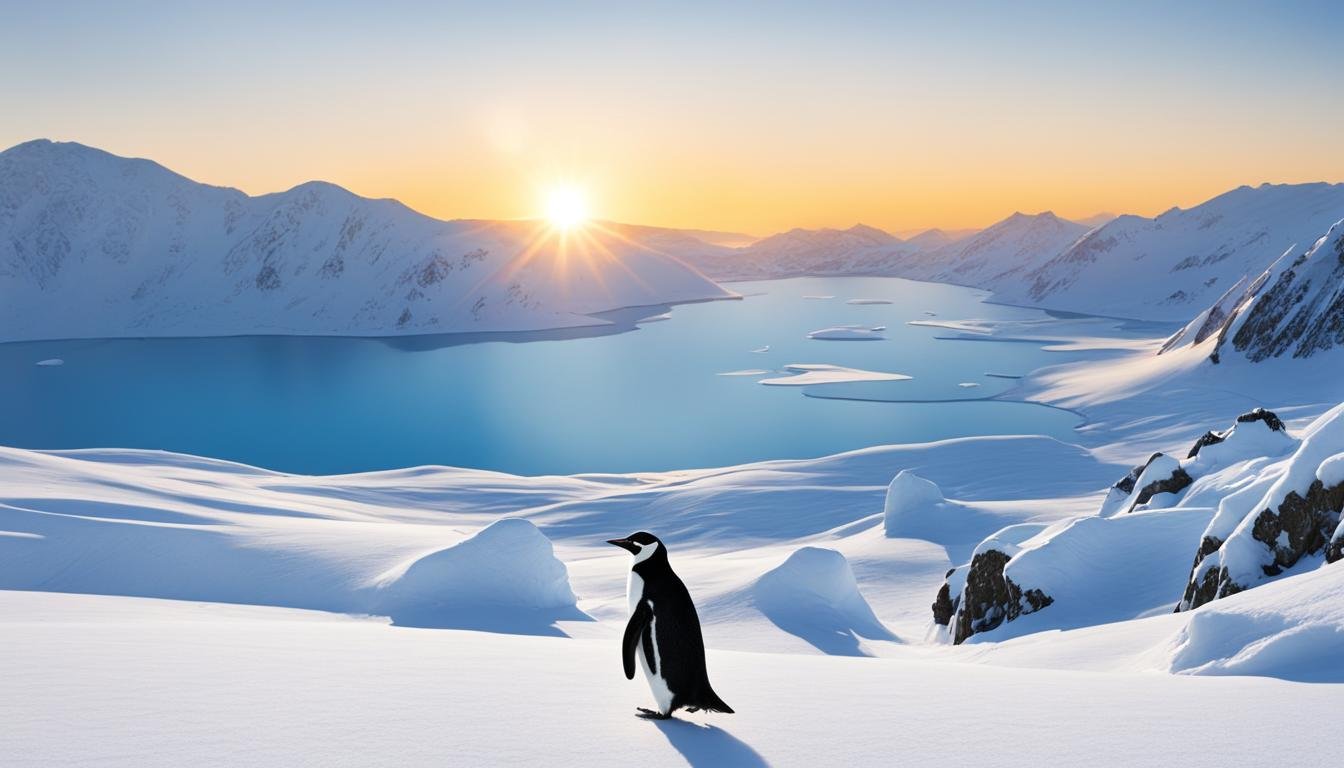When it comes to snowy conditions, Antarctica is an absolute wonderland. The vast, icy continent experiences an abundance of snowfall throughout the year, creating a picturesque landscape that is truly breathtaking. As a journalist specializing in weather and climate, I have gathered fascinating information about the weather patterns in Antarctica and its unique climate.
Antarctica is known for having the coldest climate on Earth, making it a predominantly dry continent. With an average precipitation of 166 mm (6.5 in) per year, most of this moisture takes the form of snow. The frigid temperatures in Antarctica allow the snow to accumulate without melting, resulting in the formation of massive glaciers and ice caps that cover the majority of the continent.
So, just how cold does it get in Antarctica? Well, get ready for some bone-chilling numbers. The lowest recorded temperature ever documented on Earth was in Antarctica, reaching a mind-boggling -89.2°C (-128.6°F). However, it’s important to note that temperatures along the coast are slightly milder, with the warmest parts hovering around -10°C (14.0°F), while the elevated inland areas can drop as low as -55°C (-67.0°F).
As you can imagine, the unique climate of Antarctica brings forth some fascinating weather patterns. The continent is mostly shielded from weather fronts that attempt to penetrate its surface due to powerful katabatic winds. Most of the precipitation occurs as snow, with rain being a rarity. However, the distribution of snowfall can vary greatly across different regions of Antarctica, with some coastal areas receiving several meters of snow per year while the interior only sees a few centimeters, classifying it as a desert.
While Antarctica’s snowfall contributes to its stunning beauty, it also serves an essential purpose. The accumulation of snow helps protect the fragile ice shelves and acts as a natural buffer against surface melt. It plays a crucial role in balancing the effects of climate change and mitigating sea level rise.
Key Takeaways:
- Antarctica experiences significant snowfall and has a predominantly dry climate.
- The continent’s extreme temperatures can reach record lows, with the lowest recorded temperature being -89.2°C (-128.6°F).
- Precipitation in Antarctica mostly falls as snow, with rain being rare.
- The distribution of snowfall varies across different regions, with coastal areas receiving more snow than the interior.
- Snowfall plays a vital role in protecting ice shelves and mitigating the effects of climate change.
The Unique Climate of Antarctica
Antarctica is renowned for its unique climate, characterized by extreme cold and dry weather. Most of the continent experiences an ice-cap climate, with the presence of katabatic winds that prevent weather fronts from penetrating far into the interior.
The average total precipitation in Antarctica is around 166 millimeters (6.5 inches) per year, but this varies greatly across different regions. The majority of the precipitation falls as snow, while rainfall is rare. Winter in Antarctica brings significant snow accumulation, contributing to the continent’s vast ice mass.
The weather conditions in Antarctica can be highly variable, with the presence of atmospheric rivers and intense snowfall events. These atmospheric rivers are narrow bands of concentrated moisture that can transport significant amounts of moisture across the continent, leading to localized heavy snowfall in certain regions.
Precipitation in Antarctica
| Region | Precipitation (mm/year) |
|---|---|
| Coastal Areas | High precipitation due to atmospheric rivers |
| Interior | Low precipitation, classified as a desert |
Despite the overall dryness of the continent, Antarctica receives significant snowfall near the coast, where several meters of snow can accumulate annually. In contrast, the interior of Antarctica only receives a few centimeters of snowfall each year, resulting in a desert-like environment.
With its extraordinary climate and unique precipitation patterns, Antarctica serves as a captivating subject of study for scientists and researchers seeking to understand the Earth’s climatic systems and the impact of climate change.
The Temperature in Antarctica

The temperature in Antarctica can be extreme, varying based on location and season. Let’s take a closer look at the highest and lowest recorded temperatures in this icy continent.
The Highest Temperature in Antarctica
When it comes to the highest temperature ever recorded in Antarctica, Signy Research Station takes the crown. On one fateful day, the mercury rose to a surprising 19.8°C (67.6°F), providing a brief respite from the frigid conditions. Another notable high-temperature record was set at the Esperanza Base on the mainland, where the thermometer reached 18.3°C (64.9°F).
The Lowest Temperature in Antarctica
At the other end of the spectrum, Antarctica holds the record for the lowest recorded temperature on Earth. Vostok Station, known for its bone-chilling climate, experienced a jaw-dropping -89.2°C (-128.6°F). To put this into perspective, that’s colder than subliming dry ice!
While the interior of Antarctica experiences a mean annual temperature of around -43.5°C (-46.3°F), the coast is relatively warmer. These temperature extremes truly highlight the unique and challenging climate of Antarctica.
| Location | Highest Temperature (°C) | Highest Temperature (°F) | Lowest Temperature (°C) | Lowest Temperature (°F) |
|---|---|---|---|---|
| Signy Research Station | 19.8°C | 67.6°F | N/A | N/A |
| Esperanza Base | 18.3°C | 64.9°F | N/A | N/A |
| Vostok Station | N/A | N/A | -89.2°C | -128.6°F |
Precipitation Patterns in Antarctica

In Antarctica, the distribution of precipitation varies significantly across different regions. The amount of snowfall differs depending on the proximity to the coast and the elevation. While coastal areas near the Peninsula can receive several meters of snowfall each year, the interior parts of the continent receive only a few centimeters, making them classified as deserts.
The precipitation rates in Antarctica can range from high values near the coast to very low values in the high interior areas. Most of the precipitation in Antarctica falls as snow, and rain is rare. The continent’s extreme dryness contributes to the low absolute humidity in the air.
To give you a better understanding of precipitation patterns in Antarctica, refer to the table below:
| Location | Precipitation |
|---|---|
| Coastal Areas | Several meters of snowfall annually |
| Interior | Only a few centimeters of snowfall annually |
As you can see, the coastal areas of Antarctica receive significantly more snowfall compared to the interior regions. This disparity in precipitation levels contributes to the diverse climate and landscape found on the continent.
Importance of Snowfall Variation
The variation in snowfall across Antarctica is essential for understanding the continent’s climate and ecosystem. The considerable snowfall near the coast helps nourish the growth of ice shelves and glaciers, contributing to the overall stability of the ice sheet. On the other hand, the limited snowfall in the interior regions results in a harsh, barren landscape.
By analyzing the precipitation patterns and studying snowfall data, scientists can gain insights into the changing climate and its impacts on Antarctica. It also helps researchers understand the dynamics of ice formation, accumulation, and loss, which are crucial for predicting future sea-level rise.
Impact of Climate Change in Antarctica
Climate change is having a profound impact on Antarctica, with significant consequences for the region’s environment and global sea levels. Rising temperatures and increased ice loss are among the key indicators of these changes.
The effects of climate change are not evenly distributed across Antarctica. In West Antarctica, temperatures are warming rapidly, leading to accelerated ice melt. Conversely, inland regions are experiencing cooling temperatures due to the influence of wind patterns.
Antarctica has already lost a considerable amount of ice, contributing to rising sea levels. Scientists estimate that by the year 2100, the water bound in ice in Antarctica alone could cause a sea level rise of 25 cm.
One of the factors that could influence the future climate and ice dynamics of Antarctica is the presence of atmospheric rivers. These elongated bands of moisture in the atmosphere can bring heavy precipitation, including snowfall, to the region. Understanding the role of atmospheric rivers in Antarctica’s climate is crucial for predicting future changes.
The impact of climate change in Antarctica extends beyond its borders. Rising sea levels affect coastal regions worldwide, threatening habitats, infrastructure, and communities. Addressing climate change and its effects on Antarctica is a global imperative.
Antarctic Ice Loss
Antarctic ice loss refers to the reduction in the mass of ice sheets and glaciers in Antarctica. This loss occurs primarily due to melting and calving, where ice breaks off from the floating ice shelves into the ocean. The accelerating ice loss in Antarctica is a major contributor to global sea level rise, posing significant risks to coastal areas.
Sea Level Rise
Sea level rise is a direct consequence of melting ice from Antarctica and other sources. As the ice sheets and glaciers in Antarctica melt, the additional water flows into the oceans, causing sea levels to rise. This phenomenon threatens coastal communities, increasing the risk of flooding, erosion, and saltwater intrusion into freshwater supplies.
Atmospheric Rivers in Antarctica
Atmospheric rivers are long and narrow corridors of concentrated moisture in the atmosphere. These atmospheric phenomena are capable of transporting large quantities of water vapor, which can lead to intense snowfall events in Antarctica. Understanding and monitoring atmospheric rivers are essential for predicting precipitation patterns and their implications for ice mass balance and climate change in the region.
Importance of Snowfall in Antarctica
Snowfall in Antarctica plays a vital role in protecting the ice shelves and buffering the surface melt. The accumulation of snow adds mass to the ice sheets and creates a layer of hardening snow, which acts as a buffer against future melting. This buffering effect helps mitigate sea level rise by absorbing and distributing the meltwater.
Moreover, snowfall provides a crucial cushion for sensitive areas of Antarctica, such as the Thwaites Glacier. This glacier is considered one of the most vulnerable to climate change and rising temperatures. The snowfall acts as a protective blanket, insulating the glacier from the warming ocean waters and reducing the risk of rapid ice loss.
Furthermore, snowfall serves to balance the ice loss caused by climate change. While ice shelves are melting and calving at an accelerated rate, snowfall replenishes the ice sheets with fresh layers of snow. This helps maintain the overall mass of Antarctica’s ice sheet and contributes to its stability, counteracting the effects of ice loss.
Benefits of Snowfall in Antarctica:
- Protection of Ice Shelves: Snowfall acts as a shield, insulating the ice shelves from warm air and ocean waters.
- Buffering Effect: The accumulation of snow helps absorb surface melt and distribute it, mitigating sea level rise.
- Balancing Ice Loss: Snowfall replenishes the ice sheets, counteracting the effects of climate change-induced ice loss.
The significance of snowfall in Antarctica cannot be underestimated. It plays a critical role in preserving the continent’s unique ecosystems and maintaining the stability of its ice sheets. Protecting and preserving Antarctica’s snowfall is crucial for mitigating the impacts of climate change and ensuring the long-term sustainability of this pristine environment.
Strange Weather Events in Antarctica
Antarctica, known for its extreme climate, has recently experienced some truly bizarre weather phenomena. From a surprising heat wave to the presence of atmospheric rivers, these events have had a profound impact on the temperature, precipitation patterns, and even the stability of ice shelves in the region.
Let’s start with the heat wave. Yes, you heard that right—Antarctica, one of the coldest places on Earth, witnessed a heat wave. During this unprecedented event, temperatures rose to alarming levels, causing significant concerns among scientists and researchers. This further reinforces the reality of climate change and its profound effects on our planet.
The rise in temperature is not the only peculiar weather phenomenon observed in Antarctica. Atmospheric rivers, which are long and narrow bands of moisture in the atmosphere, have also made their presence felt in this frozen continent. These rivers of moisture can transport vast amounts of water vapor, resulting in intense snowfall events and altered precipitation patterns.
As a consequence of these extreme weather events, the delicate balance of Antarctica’s ice shelves has been critically affected. These immense sheets of ice, which play a crucial role in stabilizing the region, have shown signs of collapse due to the changing climate and the impact of these unprecedented weather occurrences.
The Collapse of Ice Shelves
The collapse of ice shelves has become a growing concern in recent years. These massive structures act as barriers, preventing glaciers from flowing directly into the ocean and contributing to rising sea levels. However, the warming temperatures and the influx of warm ocean currents have weakened and destabilized these ice shelves, making them vulnerable to collapse.
When ice shelves collapse, they not only result in the loss of large ice masses but also accelerate the release of glaciers into the ocean. This phenomenon not only exacerbates sea level rise but also has far-reaching implications for global climate patterns.
| Weather Event | Impact |
|---|---|
| Heat wave | Rapid rise in temperatures, potential for accelerated ice melt |
| Atmospheric rivers | Intense snowfall, altered precipitation patterns |
| Ice shelf collapse | Loss of ice mass, accelerated glacier flow, increased sea level rise |
The combination of these strange weather events and the collapse of ice shelves in Antarctica raises significant questions about the future dynamics of the region. Scientists are closely monitoring these developments to better understand the impacts of climate change and the potential consequences for the stability of Antarctica’s climate, ice shelves, and sea levels.
Conclusion
In conclusion, snowfall in Antarctica is a common occurrence, with the majority of precipitation falling as snow. The climate in Antarctica is extremely cold and dry, creating ideal conditions for snow to accumulate and persist. With snow rarely melting on most parts of the continent, it forms massive ice sheets and glaciers.
The temperature in Antarctica experiences significant fluctuations, with record highs and lows. The highest temperature ever recorded was 19.8°C (67.6°F) at Signy Research Station, while the lowest temperature recorded was a bone-chilling -89.2°C (-128.6°F) at Vostok Station. These extreme temperature variations contribute to the unique and harsh climate of Antarctica.
Antarctica is not immune to the impacts of climate change. Rising temperatures and increased ice loss are reshaping the continent. The presence of atmospheric rivers, which contribute to intense snowfall events, adds another layer of complexity to Antarctica’s climate dynamics. The loss of ice in Antarctica is a significant concern, with projections suggesting that the sea level could rise by 25 cm by 2100 due to the melting ice.
Snowfall in Antarctica plays a crucial role in protecting the ice shelves and mitigating the effects of surface melt. The accumulation of snow adds mass and creates a layer of hardening snow, which helps absorb future melt and reduces the rate of sea level rise. Understanding the intricate relationship between snowfall, climate change, and ice dynamics in Antarctica requires further study and research.
FAQ
Does it snow in Antarctica?
Yes, it snows in Antarctica. The continent experiences snowfall as the majority of its precipitation, with most of it falling as snow.
What is the climate like in Antarctica?
Antarctica has a unique climate characterized by extreme cold and dry weather. It is the coldest continent on Earth, with temperatures reaching as low as -89.2°C (-128.6°F) and an average annual precipitation of 166 mm (6.5 in).
What are the temperature extremes in Antarctica?
Antarctica experiences both extreme low and high temperatures. The lowest recorded temperature on the continent was -89.2°C (-128.6°F), while the highest temperature ever recorded was 19.8°C (67.6°F).
How much snowfall does Antarctica receive?
The amount of snowfall in Antarctica varies across different regions. Near the coast, several meters of snow can fall each year, while the interior receives only a few centimeters of snowfall annually. Overall, most of the precipitation in Antarctica falls as snow.
What is the impact of climate change on Antarctica?
Climate change is affecting Antarctica, resulting in rising temperatures and increased ice loss. West Antarctica is warming rapidly, while the inland regions are cooled by winds. The continent has lost a significant amount of ice, and predictions suggest that the sea level could rise by 25 cm by the year 2100 due to ice melting.
Why is snowfall important in Antarctica?
Snowfall plays a crucial role in protecting ice shelves and buffering surface melt. It adds mass and creates a layer of hardening snow that helps absorb future melt and mitigate sea level rise. Snowfall balances the ice loss caused by climate change and has a net positive effect on Antarctica’s ice sheet.
Have there been any strange weather events in Antarctica?
Yes, Antarctica has experienced unusual weather events such as a recent heat wave and the presence of atmospheric rivers. These events have caused significant changes in temperature and precipitation patterns, including snowfall during a heat wave and the collapse of an ice shelf.
What can we conclude about snowfall in Antarctica?
Snowfall is a common occurrence in Antarctica, with the majority of precipitation falling as snow. It is an essential component of the continent’s climate and has a significant impact on protecting ice shelves and mitigating surface melt. Further research is needed to fully understand the complex dynamics of Antarctica’s climate and the role of snowfall.

Leave a Reply